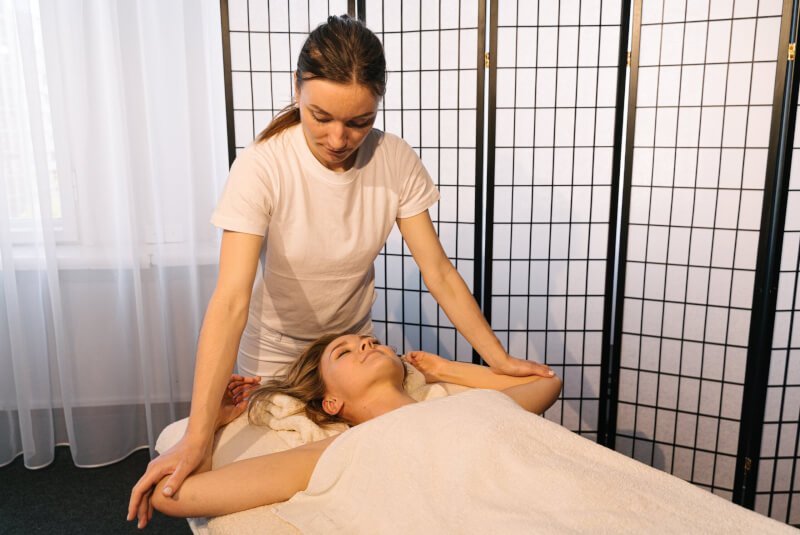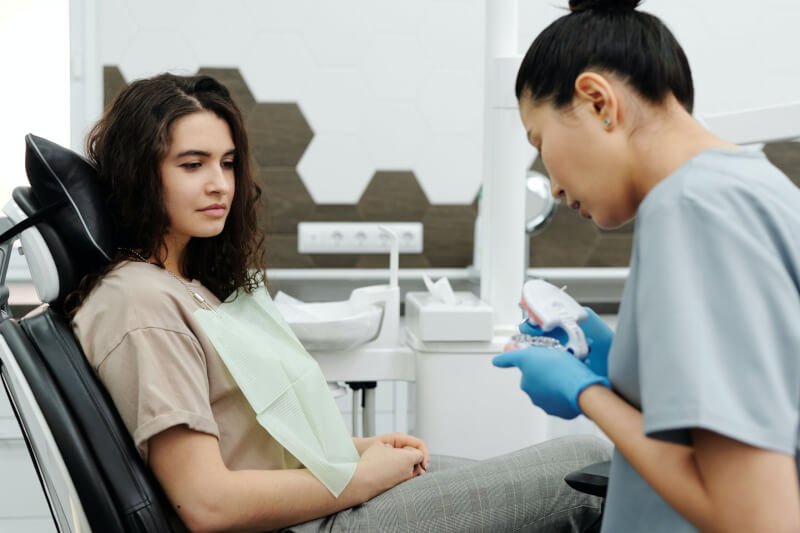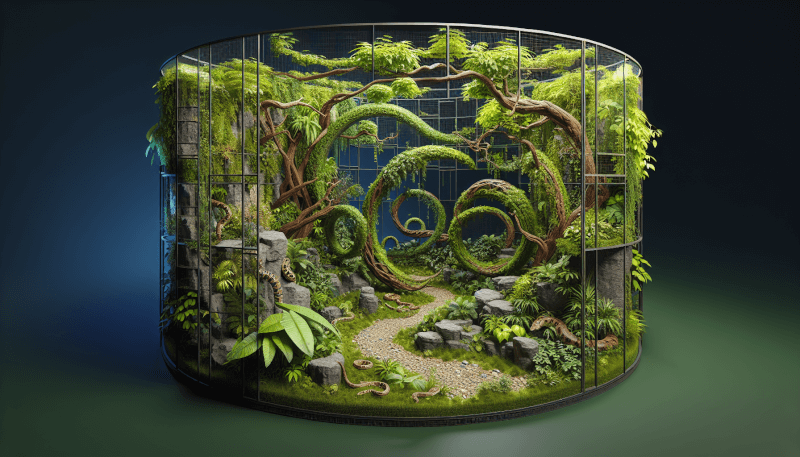In the fascinating world of reptiles, housing multiple snakes in a single enclosure can be both a joy and a challenge. Whether you’re a seasoned snake enthusiast or a curious beginner, ensuring a safe and harmonious environment for these slithering companions is essential. From temperature control to proper hiding spots, this article will guide you through the necessary steps to create a safe haven where your snakes can thrive together. So grab your notebook and let’s embark on this exciting journey of creating a safe environment for snakes in a multi-snake enclosure.

Determining the Size and Structure of the Enclosure
Calculating the Necessary Space for Each Snake
When setting up a multi-snake enclosure, it’s important to ensure that each snake has enough space to thrive. The size of the enclosure will depend on the number and size of the snakes you plan to house together. As a general rule, each snake should have enough room to stretch out fully and move around comfortably.
To calculate the necessary space for each snake, you can use a simple formula: length of the snake + width of the snake = minimum length of enclosure. For example, if you have a snake that is 4 feet long and 1 foot wide, the minimum length of the enclosure should be 5 feet. Additionally, it’s important to consider the height of the enclosure to provide vertical space for climbing snakes.
Deciding on the Type of Enclosure
When choosing the type of enclosure for a multi-snake setup, there are several options to consider. Glass terrariums, PVC cages, and wooden enclosures are all popular choices. Each type of enclosure has its own advantages and disadvantages.
Glass terrariums provide excellent visibility and are easy to clean, but they may not hold heat well and can be prone to breaks or cracks. PVC cages are lightweight, easy to clean, and retain heat better than glass, but they can be more expensive. Wooden enclosures are durable and provide good insulation, but they can be harder to clean and may require regular sealing to prevent moisture damage.
Consider your specific needs and the requirements of the snake species you plan to house to determine the best type of enclosure for your multi-snake setup.
Providing Sufficient Hiding Places
Snakes are naturally shy creatures and need plenty of hiding places in their enclosure to feel secure. Providing hiding places can help reduce stress and prevent aggressive behavior among snakes.
You can include natural or artificial hiding spots in your enclosure. These can include caves, logs, rocks, or even commercial hide boxes specifically designed for snakes. Make sure to distribute the hiding places evenly throughout the enclosure to prevent competition among the snakes.
The size of the hiding places should be appropriate for the size of the snake. Snakes should be able to comfortably fit inside their hiding spots without feeling cramped. Additionally, multiple hiding places should be provided to ensure that each snake has its own space.
Temperature and Humidity Control
Installing a Heat Source
Maintaining the right temperature in a multi-snake enclosure is crucial for the health and well-being of the snakes. Snakes are ectothermic, meaning they rely on their environment to regulate their body temperature. Therefore, it’s important to provide a heat source that allows the snakes to thermoregulate effectively.
The heat source can be a heat mat, a heat lamp, or a ceramic heat emitter, depending on the specific needs of the snake species. It’s important to position the heat source in a way that creates a temperature gradient within the enclosure, with a warm end and a cooler end. This allows the snakes to move between different temperature zones to regulate their body temperature.
Setting up a Temperature Gradient
To set up a temperature gradient in the enclosure, place the heat source at one end of the enclosure and monitor the temperatures at various points. The warm end should have a temperature range suitable for the specific snake species, while the cooler end should be several degrees lower.
Using a thermostat is crucial to ensure that the temperature remains within the appropriate range. This will prevent overheating and thermal burns. Place the thermostat probe at the level where the snakes will typically be located to get an accurate reading.
Monitoring and Adjusting the Humidity Levels
In addition to temperature, humidity levels are also important to monitor in a snake enclosure. Different snake species have varying humidity requirements, so it’s essential to research the specific needs of the snakes you plan to house.
Maintaining the correct humidity levels can help with shedding and respiratory health. You can monitor humidity using a hygrometer placed in a central location within the enclosure. If the humidity levels are too low, you can increase them by adding a moisture-retaining substrate, providing a larger water bowl, or using a reptile fogger or mister. If the humidity levels are too high, you can improve ventilation or reduce the amount of water in the enclosure.

Lighting and Photoperiod Management
Choosing the Right Type of Lighting
Lighting plays a crucial role in the overall health and behavior of snakes. While snakes don’t require UVB lighting like some reptiles, they still benefit from a regular day-night cycle and proper lighting.
For the day-night cycle, it’s important to have a consistent light schedule. A timer can be used to ensure that the enclosure receives around 12 hours of light and 12 hours of darkness each day. This helps to regulate the snakes’ biological rhythms and mimic their natural environment.
Establishing a Regular Day-Night Cycle
Snakes are crepuscular or nocturnal animals, meaning they are most active during dawn, dusk, or nighttime. Therefore, it’s important to establish a day-night cycle that aligns with their natural activity patterns.
During the day, you can use ambient lighting to provide a dimly lit environment. This can be achieved through the careful placement of LED lights or by utilizing natural light from nearby windows. At night, it’s best to provide complete darkness, as snakes are most active in low-light conditions.
Creating a Consistent Photoperiod for Snakes
In addition to the day-night cycle, maintaining a consistent photoperiod is important to regulate the snakes’ reproductive cycles. Snakes rely on changes in photoperiod to determine when to breed and when to enter a period of decreased activity.
To create a consistent photoperiod, it’s important to keep the enclosure’s lighting schedule as consistent as possible throughout the year. This means adjusting the light timers to compensate for changes in daylight hours during different seasons.
Maintaining a Clean and Hygienic Environment
Regular Spot Cleaning
Keeping a clean and hygienic environment is vital for the health of the snakes. Regular spot cleaning should be done to remove any waste or debris from the enclosure. You can use paper towels or reptile-safe substrate to make the cleaning process easier.
Check the enclosure daily for any soiled areas and promptly remove any feces or urates. Snakes should also be monitored for any signs of illness, such as diarrhea or excessive shedding, which may require additional cleaning measures.
Implementing a Deep Cleaning Schedule
In addition to spot cleaning, it’s important to establish a deep cleaning schedule. This involves removing all substrate, disinfecting the enclosure, and thoroughly cleaning all accessories and hides.
The frequency of deep cleaning will depend on the specific needs of the snake species and the size of the enclosure. Generally, a deep clean should be done every 2-4 weeks. This not only removes any build-up of bacteria or parasites but also helps to minimize odors in the enclosure.
Using Safe Cleaning Products for Snake Enclosures
When cleaning a snake enclosure, it’s important to use safe and reptile-friendly cleaning products. Avoid using any harsh chemicals or cleaning agents that could be toxic to the snakes. Instead, opt for reptile-specific cleaners or natural alternatives such as vinegar or mild soap.
Before returning snakes to the enclosure after cleaning, ensure that all cleaning products are thoroughly rinsed off. Residual chemicals could be harmful to the snakes’ skin or respiratory system.

Creating Separate Feeding Areas
Designating Individual Food Stations
In a multi-snake enclosure, it’s essential to provide separate feeding areas for each snake. Snakes can be territorial when it comes to feeding, and multiple snakes competing for food in the same area can lead to stress, aggression, or even injury.
Designating individual food stations ensures that each snake has its own space to eat without interference. These feeding areas can be as simple as separate feeding dishes or designated areas within the enclosure where each snake is given its own prey item.
Ensuring Proper Feeding Space for Each Snake
When setting up the feeding areas, ensure that there is enough space for each snake to eat comfortably. Snakes should be able to swallow their prey without any hindrance, and there should be enough room to prevent accidental ingestion of substrates or other objects.
Additionally, it’s important to monitor the feeding habits and behavior of each snake. If any snake consistently shows signs of aggression during feeding or refuses to eat, it may be necessary to adjust the feeding arrangements and consider separating the snakes during feeding times.
Implementing a Feeding Schedule
Establishing a regular feeding schedule is important for the overall health and well-being of the snakes. Snakes have varying feeding requirements depending on factors such as age, species, and size. It’s important to research the specific nutritional needs of the snake species you plan to house and create a feeding schedule accordingly.
For most adult snakes, feeding once every 1-2 weeks is sufficient. Juvenile snakes may require more frequent feedings. It’s important to monitor the snakes’ body condition and adjust the feeding schedule as needed to ensure they are neither underweight nor overweight.
Preventing Aggressive Behavior and Stress
Avoiding Overcrowding in the Enclosure
One of the key factors in preventing aggressive behavior and stress in a multi-snake enclosure is to avoid overcrowding. Too many snakes in a limited space can lead to competition for resources and increased stress levels.
Ensure that each snake has enough space to move around freely and establish their own territories. If you notice any signs of aggression between snakes, consider providing additional hiding places or rearranging the enclosure to create separate territories.
Providing Adequate Hiding and Climbing Places
In addition to avoiding overcrowding, providing adequate hiding and climbing places is essential to reduce stress and prevent aggressive behavior. Snakes need places where they can retreat and feel secure, especially in a multi-snake environment.
Include a variety of hiding places such as caves, logs, or artificial plants throughout the enclosure to cater to different snake preferences. Additionally, snakes that are good climbers should be provided with climbing structures or branches to satisfy their natural instincts.
Monitoring Interactions and Separating Aggressive Snakes
It’s important to closely monitor the interactions between snakes in a multi-snake enclosure. While some level of dominance or hierarchy is natural, aggressive behavior such as biting, lunging, or continuous harassment should not be ignored.
If aggressive behavior is observed, it may be necessary to separate the aggressive snakes temporarily. This can be done by using temporary barriers or dividers within the enclosure. Consult with a reptile veterinarian or an experienced herpetologist if you need guidance on addressing aggressive behavior in snakes.

Managing Potential Health Risks
Quarantining New Snakes
When introducing new snakes into a multi-snake enclosure, it’s crucial to quarantine them first. Quarantine is a temporary isolation period that allows you to monitor the new snakes for any signs of illness or disease before introducing them to the existing snakes.
During the quarantine period, new snakes should be housed in a separate enclosure with its own set of equipment and supplies. This prevents the potential spread of any contagious diseases or parasites to the other snakes.
Regular Health Check-ups
Regular health check-ups are essential for maintaining the well-being of the snakes in a multi-snake enclosure. Schedule regular visits to a reptile veterinarian who has experience with snakes to ensure that the snakes receive appropriate care and preventive treatments.
During these check-ups, the veterinarian will perform a thorough examination, check for signs of illness, and address any concerns or questions you may have. Regular health check-ups can help catch potential issues early and provide prompt treatment.
Addressing Signs of Illness or Disease
It’s important to monitor the snakes in a multi-snake enclosure for any signs of illness or disease. Common signs of illness in snakes include abnormal behavior, difficulty breathing, changes in appetite, weight loss, or abnormalities in shedding.
If you notice any signs of illness or disease, it’s important to take immediate action. Isolate the affected snake from the others and seek veterinary care as soon as possible. Prompt diagnosis and treatment are crucial for ensuring the best chances of recovery.
Securing the Enclosure to Prevent Escapes
Choosing the Right Type of Enclosure
One of the key factors in preventing snake escapes is choosing the right type of enclosure. Regardless of the material, the enclosure should be secure and escape-proof.
Glass terrariums should have tight-fitting and lockable screen tops to prevent snakes from pushing or lifting the lid. PVC cages or wooden enclosures should have secure latches or locks on the doors to prevent accidental openings. Additionally, ensure that there are no gaps or openings in the enclosure that snakes could squeeze through.
Adding Extra Locks or Latches
To further secure the enclosure and prevent snake escapes, it’s advisable to add extra locks or latches. Snakes are surprisingly strong and can push open doors or lids if they aren’t properly secured.
Consider adding sliding locks, padlocks, or combination locks to the enclosures, depending on the design and structure. These additional security measures can provide peace of mind and reduce the risk of snakes escaping.
Regularly Inspecting and Maintaining the Enclosure
Regular inspections and maintenance are essential for keeping the enclosure secure. Check the enclosure regularly for any signs of wear or damage, such as loose hinges, weak spots, or damaged screens. Repair or replace any compromised areas immediately.
Additionally, ensure that all equipment, such as heating elements or lighting fixtures, are properly secured and cannot be tampered with by the snakes. Regular maintenance and vigilance are key in preventing escapes and ensuring the safety of the snakes.

Educating Yourself and Seeking Expert Advice
Researching Snake Species and Behavior
To provide the best care for snakes in a multi-snake enclosure, it’s important to educate yourself about the specific snake species you plan to house. Each snake species has its own unique requirements in terms of habitat, temperature, humidity, and feeding.
Research the natural habitat, behavior, and feeding habits of the snakes to gain a better understanding of their needs. This will help you create a suitable environment and promote the overall health and well-being of the snakes.
Consulting Reputable Exotic Pet Professionals
If you’re new to keeping snakes or are unsure about specific aspects of multi-snake enclosure care, it’s advisable to consult reputable exotic pet professionals. These professionals, such as experienced herpetologists or reptile veterinarians, have the knowledge and expertise to guide you in creating a safe environment for your snakes.
Ask for recommendations from local reptile clubs or organizations, or seek out professionals who specialize in reptiles. They can provide valuable advice and answer any questions you may have regarding the care and maintenance of a multi-snake enclosure.
Joining Online Communities or Forums for Snake Keepers
Online communities and forums dedicated to snake keeping are excellent resources for exchanging information and seeking advice from experienced snake keepers. These platforms allow you to connect with fellow snake enthusiasts, share your experiences, and learn from others.
Participating in online discussions, asking questions, and reading through existing threads can provide valuable insights into the challenges and best practices of maintaining a safe environment for snakes in a multi-snake enclosure. Always remember to verify the credibility of the information by consulting multiple sources.
Monitoring and Responding to Environmental Changes
Regularly Checking Temperature and Humidity Levels
Environmental conditions in a snake enclosure can fluctuate due to various factors such as seasonal changes or equipment malfunctions. It’s important to regularly monitor the temperature and humidity levels to ensure they remain within the appropriate ranges for the snakes’ well-being.
Use reliable thermometers and hygrometers to measure the temperature and humidity in different zones of the enclosure. Make adjustments as necessary to maintain optimal conditions. If you notice significant fluctuations, investigate the cause and address it promptly.
Adjusting Heating and Cooling Equipment
Heating and cooling equipment such as heat lamps or air conditioners may need periodic adjustments to accommodate changes in ambient temperature. This is especially important during seasonal transitions when temperature fluctuations can be more pronounced.
Monitor the temperature in the enclosure and adjust the heating or cooling equipment as needed to maintain the desired temperature ranges. This will help prevent temperature extremes that could negatively impact the snakes’ health.
Preparing for Seasonal Changes
Seasonal changes can have a significant impact on the environmental conditions in a snake enclosure. It’s important to prepare for these changes and make any necessary adjustments to ensure the snakes remain comfortable and healthy.
During colder months, additional heating may be required to maintain appropriate temperature ranges. This can be achieved by adjusting the wattage of heat sources or using additional heating elements. Conversely, during warmer months, it may be necessary to provide additional ventilation or cooling methods to prevent overheating.
By staying proactive and being prepared for seasonal changes, you can help create a safe and comfortable environment for the snakes throughout the year.


